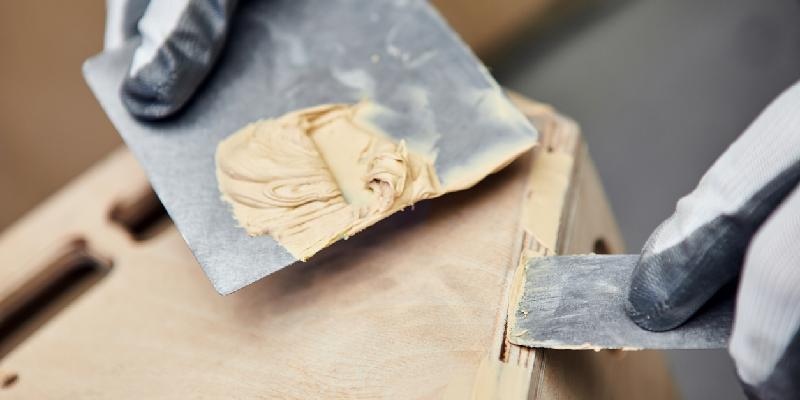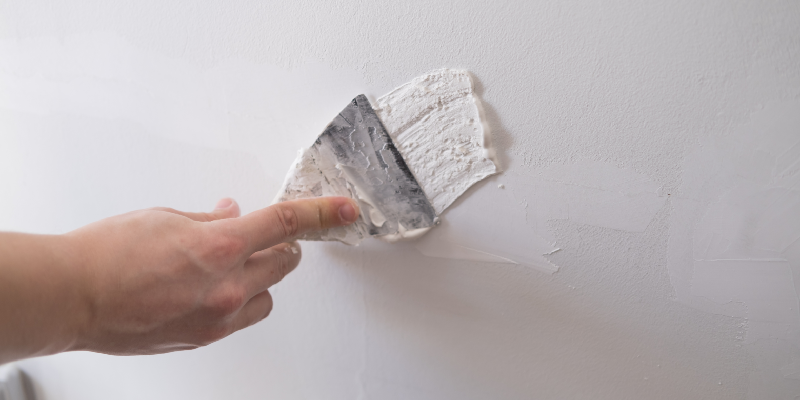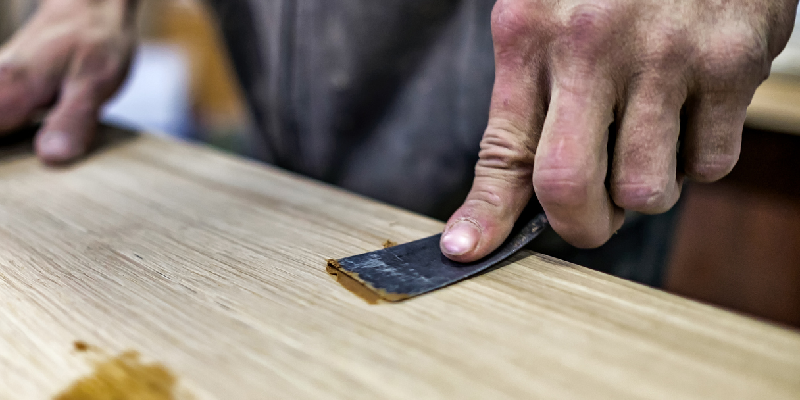The right materials can make all the difference in any DIY home improvement job. Two debated products are wood filler and spackle. Both are used to fill and repair holes and imperfections, but they serve different purposes and have unique characteristics. Which one you use is a matter of the material you’re working with and the type of repair you’re doing.

What is Wood Filler?
Wood filler, often confused with wood putty, is a substance used primarily in woodworking to fill small holes, gouges, and dents in wood. It’s designed to adhere well to wood surfaces and can be sanded down to a smooth finish once dry.
Types of Wood Filler
There are several types of wood fillers, including:
- Water-based wood filler: Made from cellulose, it’s easy to clean up and dries quickly.
- Oil-based wood filler: Contains solvents and offers longer working time. It’s more durable than its water-based counterpart.
- Epoxy wood filler: A two-part system that hardens to fill holes in in wood and is incredibly strong.
- Sawdust and wood glue: For those who love a good DIY solution, creating a wood filler at home is possible. By mixing sawdust from the same type of wood as your project with wood glue, you can create a filler that matches the wood’s texture and color closely. This is especially useful for woodworking projects where aesthetics are crucial.
Benefits of Using Wood Filler
- Versatility in Woodworking: Wood filler is stainable, meaning it can take on the color of the surrounding wood finish. This makes it ideal for repairs that will be visible in the final product.
- Drying Time: Depending on the type, some wood fillers can dry in as little as 15 minutes.
- Shrinkage: High-quality wood fillers have minimal shrinkage, ensuring the repair remains flush with the surrounding surface.
- Adhesion: Designed specifically for wood, these fillers offer excellent adhesion to wood surfaces, from baseboards to wood trim.

What is Spackle?
Spackle, or spackling compound, is primarily used to fill nail holes, small cracks, and dents in drywall. It’s made from gypsum and binders, which allow it to dry quickly and adhere well to gypsum-based drywall.
Types of Spackle
- Standard spackle: Ideal for small repairs and dries quickly.
- Lightweight spackle: Easier to spread and perfect for filling small holes, it’s made from sodium silicate and adhesive
- Vinyl spackle: Contains vinyl, increasing durability and reducing shrinkage.
- Joint compound: Sometimes confused with spackle, it’s used for larger drywall repairs.
Benefits of Using Spackle
- Easy Application: With a putty knife, spackle can be easily applied and smoothed out.
- Quick Drying: Lightweight spackle, for instance, dries in under an hour.
- Sandable: Once dried, spackle can be sanded to a smooth finish, ensuring a seamless repair.
- Minimal Shrinkage: Especially with vinyl spackle, there’s minimal shrinkage, ensuring the filled areas don’t sink below the wall surface.
Wood Filler vs Spackle: Key Differences Explained
Intended Use
- Wood Filler: As the name suggests, wood filler is intended for use on wood. It’s perfect for woodworking projects, repairing wood trim, and addressing imperfections in wooden surfaces.
- Spackle: For drywall repairs, you should use spackle. Whether you’re filling nail holes or addressing dents, spackle is designed to bond with gypsum, the primary component of drywall.
Composition
- Wood Filler: This can be made from cellulose, epoxy, polyurethane, or a combination of sawdust and wood glue.
- Spackle: Primarily made from gypsum, with variations like vinyl spackle or acrylic binders added for specific properties.
Drying Time and Sanding
Both wood filler and spackle offer quick drying times, but the exact time can vary based on the product type and weather conditions. Once dry, both can be sanded to achieve a smooth surface. However, always check the product’s label as some might require priming before painting.
Making the Right Choice for Your Project
Consider the Material
If you’re working with wood – be it filling gouges in a hardwood floor or addressing imperfections in wooden furniture – wood filler is your best bet. For drywall repairs, spackle is the clear choice.
Think About the Size of the Repair
For large holes in drywall, you might want to consider a joint compound or even a patch. For deeper holes in wood, an epoxy wood filler might be more appropriate than standard fillers.
Check Product Reviews
Platforms like Amazon offer user reviews for products like DAP wood filler or various types of spackle. These reviews can provide insights into drying times, ease of use, and the final finish of the product.
Safety First
Always check for volatile organic compounds (VOCs) in the product. While many modern fillers and spackles have reduced VOCs, it’s essential to ensure good ventilation when working with these products.
Achieve a Smooth Finish
For both wood filler and spackle, the key to a professional-looking finish is sanding. Once your filler or spackle has dried, use sandpaper or a sander to smooth out the surface. Start with a coarser grit and work your way to a finer one for the best results.
Painting and Staining Over Filler and Spackle
Before painting over spackle, it’s often recommended to apply a primer. This ensures even paint absorption and a uniform appearance. For wood fillers, especially if they’re stainable, you can apply a wood stain to match the surrounding area. Always test a small, inconspicuous area first to ensure the desired result.
Storage and Shelf Life
Both wood filler and spackle have a shelf life. Ensure you seal their containers tightly after use to prevent them from drying out. If your filler or spackle has hardened in its container, it’s best to purchase a new one for optimal results.
Conclusion
Whether you’re a seasoned DIY enthusiast or just starting in home improvement, understanding the differences between wood filler and spackle is crucial. By considering the material you’re working with, the size of the repair, and the specific needs of your project, you can make an informed decision and achieve a professional-looking finish. Remember, the key is in the details – and choosing the right filler can make all the difference.














































































